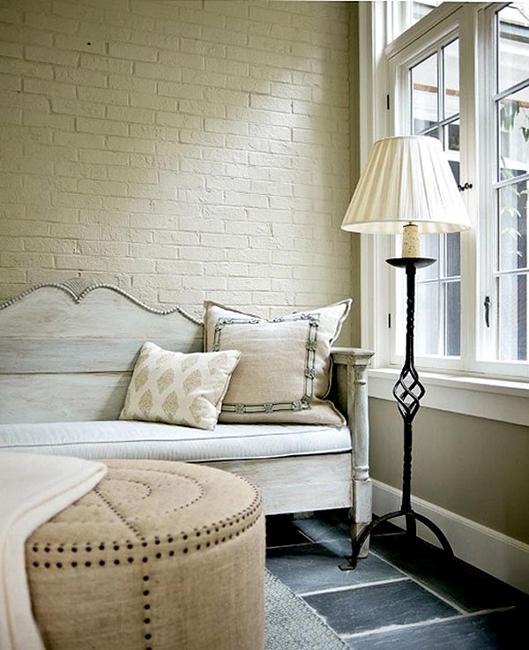Many of our suburban homes have bricks either on the outside or interior. Unfortunately these bricks can be very dark & look amazingly dated. Paint is the easiest, & usually most cost effective way to jazz up most surfaces. 
Painted bricks can give a patterned or textured appearance which can add depth to the room without the dark, overbearing colours of the brick. It sits well with the French Provincial or Hamptons look, & when painted in a patchy manner can also have an Industrial feel.
What are the main benefits or downfalls of painting your bricks? Lets break it down –
Pros
- It’s a quick fix
- Most people can DIY painting

- Cost effective
- A massive change of colour, with millions of paint colour options
Cons
- Painted finishes can scratch or chip more than solid finishes
- It will take multiple coats to cover
- Can be hard to paint in the recessed mortar
- Dust can settle in the recesses of the brick making it look dirty
- A flat overall colour rather than variations
- Hard to remove if you don’t like the look
Brick & timber features in the home can look stunning but they come with a deeper colour palette which is not always the best look. You may choose to plasterboard or Gyprock the whole wall, but that entails cutting around or refitting cornice, skirting, light fittings & power points. Let alone undercoating & top coat painting the plasterboard surface.
Painting the bricks can be an easier option, so how do you do it?
Firstly – Clean.
If it is exterior brick, give it a pressure wash & then when dry brush with a stiff bristled, clean broom to remove any dust or dirt. For Interior brick, just vacuum with the brush attachment to pick up dust or dirt.
Secondly – Primer.
Ideally it’s best to use a water-based primer first. Bricks are porous & can soak in paint. You may lose quite a lot of paint into the bricks with your first coat. This also ensures the paint sticks to the bricks.
This can be done with any colour of acrylic (water-based) paint. Two top coats are required to get full coverage of colour. You can choose this in Gloss, Satin, Low Sheen or Matt for the exact look you want.
Tips to Painting Brick
Do you have raked mortar? That basically means is your mortar between the bricks recessed back or flush with the face of the brick? If it is flush it is easier to paint with a standard roller sleeve or brush. If it is raked back it is harder to get the paint into the crevices. You may need a thicker nap roller or brush along all the lines. This is where dust can settle long term – however with painted bricks you can now see the dust which was there before but hiding on the dark bricked finish.
Specialty finishes
It is easier to paint the whole lot, but you can play with different finishes. This can be only painting the face & leaving the mortar the original colour, or watering the paint down or sponging it on for a washed appearance.
When deciding on if to paint or not to paint, ask yourself – what’s the alternative? If you were planning on rendering, replacing or plastering over the bricks anyway, why not give it a try first. This same school of thought can be used for other finishes around you home like if you want to paint laminate kitchens or bathroom tiles. See this free blog for more information on those options – http://www.mystereedesigns.com.au/budget-kitchen-makeover/



